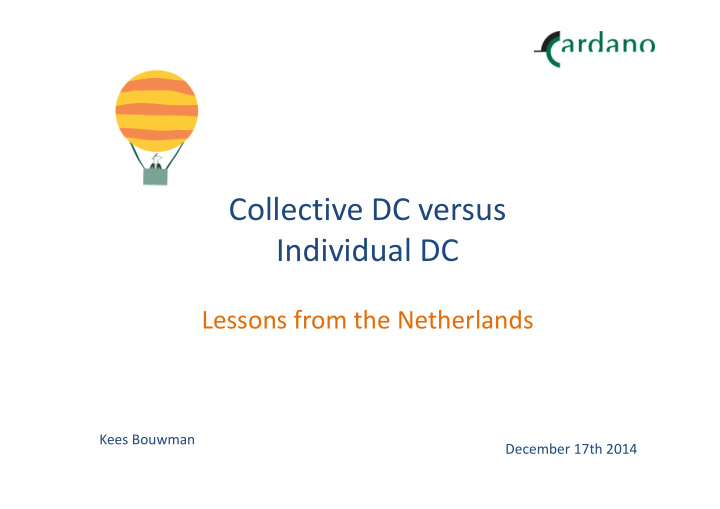



Collective DC versus Individual DC Lessons from the Netherlands Kees Bouwman December 17th 2014
Pension debate in UK vs Netherlands UK and Dutch debate moves in opposite directions Dutch debate: Collec ve DC → Individual DC UK debate: Individual DC → Collec ve DC Do UK and NL converge or cross over? Collective DC: A pension miracle? Different research claims big pension improvements for CDC For example RSA finds an improvement of 33% in (median) pension outcome, with less risk than IDC 2
How to compare CDC and IDC? Don’t compare apples with pears! Bad comparisons between CDC and IDC � Differences in risk profile � CDC not in equilibrium → new CDC member starts with a gain or loss Our approach: Let IDC match CDC as close as possible Steps 1. Simulate CDC to an equilibrium 2. Calculate economic value and risk profile of CDC pension for different ages 3. Try to replicate CDC by IDC by matching CDC risk profile 3
Dutch CDC system in a Nutshell 1. Members accrual of nominal annuity rights 2. Collective asset mix: 50-50 3. Shocks in funding ratio smoothed out in annuity rights – Annuity rights are cut or increased by about 10% of the shock per year 4. Pensions paid from annuity rights 4
Economics of CDC vs IDC Economies of scale � Collective execution of pensions can reduce costs � Collective execution can also be done in an individual accounts system (IDC) Insurance risk sharing � Sharing individual life risks (idiosyncratic) � Large welfare gains by pooling collectively (the insurance business model) � Insurance also in IDC Intergenerational risk sharing � Sharing systematic risks with future members (investing on their behalf) � extends investment horizon to before entry → be er risk return tradeoff � Welfare gains are found to be small in NL (about 1%) � Discontinuity risks � Requires mandatory participation! Sharing untradeable risks � Systematic risks: inflation risk (NL) and macro-longevity risk � Implicit forced trade with implicit price � Welfare gains? Only for right price and quantity 5
CDC follows an implicit life cycle CDC exposure to risky assets 250% 200% percentage in risky assets 150% 100% 50% 0% 30 40 50 60 70 80 age � Smoothing in CDC produces life cycle � Life cycle comparable to IDC life cycles � Risk taking during retirement � Leveraged exposure for young members 6
How much risk is shared with future members? 16% � 1.8% of shock is absorbed by future 14% members p ro p o rtio n o f to ta l ris k e x p o s u re 12% 10% � Increases expected pension outcome by 4% 8% but with extra pension risk 6% 4% � Increase IDC risky exposure 4% to match CDC 2% risk exposure due to IGRS 0% <25 25-30 30-35 35-40 40-45 45-50 50-55 55-60 60-65 65-70 70-75 75-80 80-85 85-90 age cohorts � Welfare gain is estimated to be less than 1% of extra life time consumption � Why is effect so small? – Shocks are quickly absorbed (10% p.a.) – Future members have little pension wealth to absorb a shock 7
Problems with Dutch CDC? � Interest rate risk is not shared well → old absorb interest rate risk from the young! � All risks are shared via funding ra o → no tailoring of risk pro fi les � Political risks and governance issues � Changes can shift pension value between CDC members – Valuation of annuity rights (UFR) – Distribution rules � Consequences of potential redistribution are – Di ffi cult to change or reform system → poten ally redistribute value – Difficult to transfer between pension solutions – Potential PAYG features (young sponsoring old members) 8
Conclusion � Don’t compare apples and pears! � Comparison based on best replicating IDC � Smoothing in CDC corresponds to life cycle in IDC � Effects from intergeneration risk sharing in Dutch CDC’s are small 9
Recommend
More recommend